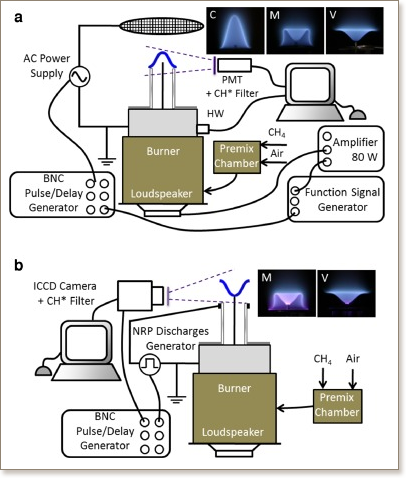

Transfer functions of laminar premixed flames subjected to forcing by acoustic waves, AC electric fields, and non-thermal plasma discharges
D.A. Lacoste, Y. Xiong, J.P. Moeck, S.H. Chung, W.L. Roberts, M.S. Cha

The responses of laminar methane–air flames to forcing by acoustic waves, AC electric fields, and nanosecond repetitively pulsed (NRP) glow discharges are reported here. The experimental setup consists of an axisymmetric burner with a nozzle made from a quartz tube. Three different flame geometries have been studied: conical, M-shaped and V-shaped flames. A central stainless steel rod is used as a cathode for the electric field and plasma excitations. The acoustic forcing is obtained with a loudspeaker located at the bottom part of the burner. For forcing by AC electric fields, a metallic grid is placed above the rod and connected to an AC power supply. Plasma forcing is obtained by applying high-voltage pulses of 10-ns duration applied at 10 kHz, between the rod and an annular stainless steel ring, placed at the outlet of the quartz tube. The chemiluminescence of CH* is used to determine the heat release rate fluctuations. For forcing by acoustic waves and plasma, the geometry of the flame plays a key role in the response of the combustion, while the flame shape does not affect the response of the combustion to electric field forcing. The flame response to acoustic forcing of about 10% of the incoming flow is similar to those obtained in the literature. The flames are found to be responsive to an AC electric field across the whole range of frequencies studied. A forcing mechanism, based on the generation of ionic wind, is proposed. The gain of the transfer function obtained for plasma forcing is found to be up to 5 times higher than for acoustic forcing. A possible mechanism of plasma forcing is introduced.